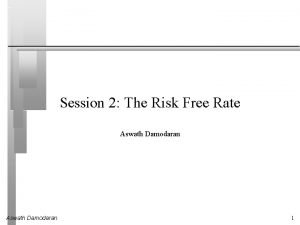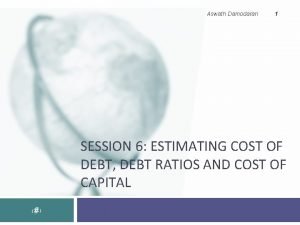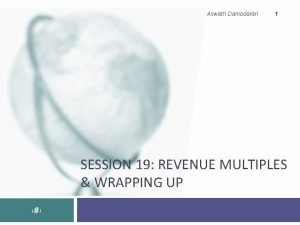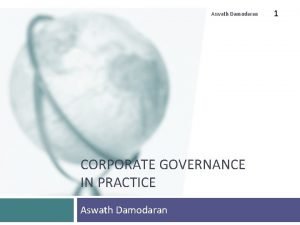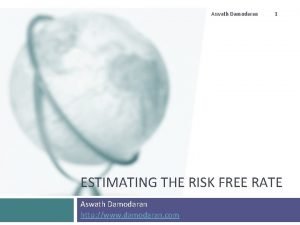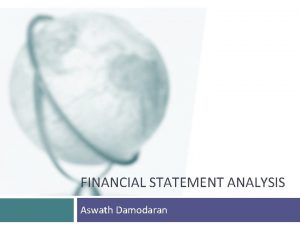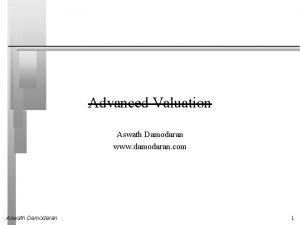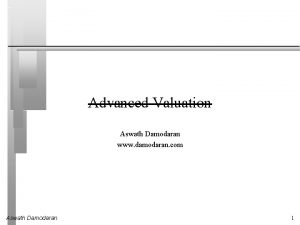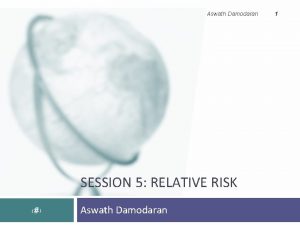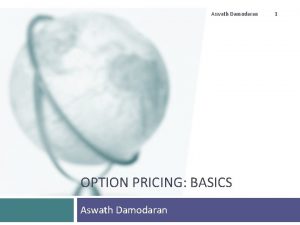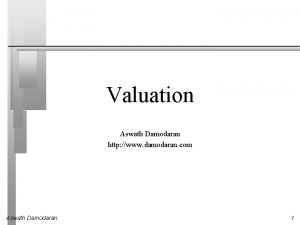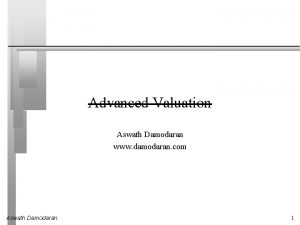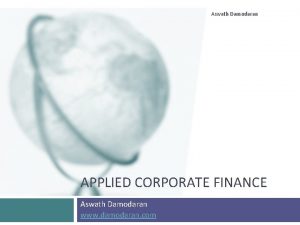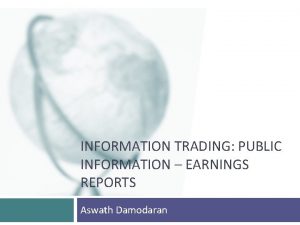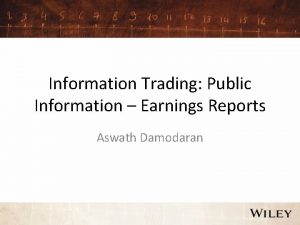Information Trading Following the analysts Aswath Damodaran Analysts















- Slides: 15

Information Trading: Following the analysts Aswath Damodaran

Analysts • Analysts have access to public information and to the managers of the firm (and thus to private information). • Analysts make earnings forecasts for firms (and revise them) and recommendations on buy and sell.

Who do analysts follow?

Determinants of analyst following… • Market Capitalization: The larger the market capitalization of a firm, the more likely it is to be followed by analysts. • Institutional Holding: The greater the percent of a firm’s stock that is held by institutions, the more likely it is to be followed by analysts. The open question, though, is whether analysts follow institutions or whether institutions follow analysts. Given that institutional investors are the biggest clients of equity research analysts, the causality probably runs both ways. • Trading Volume: Analysts are more likely to follow liquid stocks. Here again, though, it is worth noting that the presence of analysts and buy (or sell) recommendations on a stock may play a role in increasing trading volume.

I. Earnings Forecasts • Analysts spend a considerable amount of time estimating the earnings per share that companies will report in the next quarter. They also provide forecasts of earnings further out - up to 5 years. • Analysts also constantly update these forecasts as new information comes out. To the extent that there is information in these revisions, stock prices should react.

Information in Earnings Forecasts • • • Firm-specific information that has been made public since the last earnings report: Analysts can use information that has come out about the firm since the last earnings report, to make predictions about future growth. Macro-economic information that may impact future growth : Analysts can update their projections of future growth as new information comes out about the overall economy and about changes in fiscal and monetary policy. Information revealed by competitors on future prospects: Analysts can also condition their growth estimates for a firm on information revealed by competitors on pricing policy and future growth. Private information about the firm: Analysts sometimes have access to private information about the firms they follow which may be relevant in forecasting future growth. Public information other than earnings: It has been shown, for instance, that other financial variables such as earnings retention, profit margins and asset turnover are useful in predicting future growth. Analysts can incorporate information from these variables into their forecasts.

The Quality of Earnings Forecasts • The general consensus from studies that have looked at short-term forecasts (one quarter ahead to four quarters ahead) of earnings is that analysts provide better forecasts of earnings than models that depend purely upon historical data. The mean relative absolute error, which measures the absolute difference between the actual earnings and the forecast for the next quarter, in percentage terms, is smaller for analyst forecasts than it is forecasts based upon historical data. • A study in 1978 measured the squared forecast errors by month of the year and computed the ratio of analyst forecast error to the forecast error from time-series models of earnings. It found that the time series models actually outperform analyst forecasts from April until August, but underperform them from September through January. • The other study by O'Brien (1988) found that analyst forecasts outperform the time series model for one-quarter ahead and two-quarter ahead forecasts, do as well as the time series model for three-quarter ahead forecasts and do worse than the time series model for four-quarter ahead forecasts.

Analyst Errors seem to be related to macroeconomic conditions…

How about long term forecasts? • There is little evidence to suggest that analysts provide superior forecasts of earnings when the forecasts are over three or five years. An early study by Cragg and Malkiel compared long-term forecasts by five investment management firms in 1962 and 1963 with actual growth over the following three years to conclude that analysts were poor long term forecasters. • This view was contested in 1988 by Vander Weide and Carleton who found that the consensus prediction of five-year growth in the I/B/E/S was superior to historically oriented growth measures in predicting future growth.

Market Reaction to Earnings Revisions… • In one of the earliest studies of this phenomenon, Givoly and Lakonishok created portfolios of 49 stocks in three sectors, based upon earnings revisions, and reported earning an excess return on 4. 7% over the following four months on the stocks with the most positive revisions. • Hawkins, in 1983, reported that a portfolio of stocks with the 20 largest upward revisions in earnings on the I/B/E/S database would have earned an annualized return of 14% as opposed to the index return of only 7%. • In another study, Cooper, Day and Lewis report that much of the excess returns is concentrated in the weeks around the revision – 1. 27% in the week before the forecast revision, and 1. 12% in the week after, and that analysts that they categorize as leaders (based upon timeliness, impact and accuracy) have a much greater impact on both trading volume and prices. • In 2001, Capstaff, Paudyal and Rees expanded the research to look at earnings forecasts in other countries and concluded that you could have earned excess returns of 4. 7% in the U. K, 2% in France and 3. 3% in Germany from buying stocks with the most positive revisions.

Potential Pitfalls and possible use… • The limitation of an earnings momentum strategy is its dependence on two of the weakest links in financial markets –earnings reports that come from firms (where accounting games skew earnings)and analyst forecasts of these earnings (which are often biased). • To the extent that analysts influence trades made by their clients, they are likely to affect prices when they revise earnings. The more influential they are, the greater the effect they will have on prices, but the question is whether the effect is lasting. • It is a short-term strategy that yields fairly small excess returns over investment horizons ranging from a few weeks to a few months. • One way you may be able to earn higher returns from this strategy is to identify key analysts and build an investment strategy around forecast revisions made by them, rather than looking at consensus estimates made by all analysts. While forecast revisions and earnings surprises by themselves are unlikely to generate lucrative portfolios, they can augment other more long-term screening strategies.

II. Recommendations: Some background

Market Reaction…

Tempered by fears of bias…

Using Analyst Recommendations… • Can you make money off analyst recommendations? – Stock prices should go up on recommendations, even if there is no new information in them, because there is a self fulfilling prophecy. – If this is the only reason for the stock price reaction, though, the returns are not only likely to be small but could very quickly dissipate. • A four step process to getting the most out of analysts: – Identify the analysts who are not only the most influential but also have the most content (private information. Recommendations backed up by numbers and a solid story have more heft to them. – Screen out analysts where the potential conflicts of interest are too large for the recommendations to be unbiased. – You should invest based upon the recommendations, preferably at the time the recommendations are made. – Assuming that you still attach credence to the views of the recommending analysts, you should watch analysts for signals that they have changed or are changing their minds.
 Damodaran risk free rates
Damodaran risk free rates Www.damodaran
Www.damodaran Damodaran com
Damodaran com Growth investment definition
Growth investment definition Damodaran statistics
Damodaran statistics Aswath damodaran interest coverage ratio
Aswath damodaran interest coverage ratio Damodaran multiple
Damodaran multiple Aswath damodaran net worth
Aswath damodaran net worth Aswath damodaran discount rate
Aswath damodaran discount rate Ebitda multiples for trucking companies
Ebitda multiples for trucking companies Aswath damodaran age
Aswath damodaran age Risk free rate damodaran
Risk free rate damodaran Damodarans
Damodarans Contrarian value investing
Contrarian value investing Aswath damodaran accounting 101
Aswath damodaran accounting 101 Aswath damodaran
Aswath damodaran
